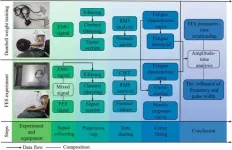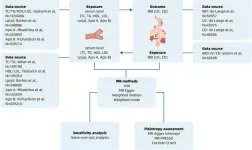(Press-News.org) Images
Simultaneously advancing biomaterials research with clinical applications and connecting researchers at well-resourced institutions with those rich in diverse talent is the aim of a $10.5 million center supported by the National Institutes of Health.
The Humanity Unlocking Biomaterials center, led by the University of Michigan and University of Washington, is designed to spur the development of biomaterials solutions that have potential in medical treatments by bringing together researchers and providing seed funding to kickstart projects. The proposal invokes a concept from the Black feminist thinker bell hooks, known as centering margins. If rapid progress is to be made, those who occupy positions of power at the center of the group must partner with and make space for those at the margins.
HUB center leads Lola Eniola-Adefeso, the Vennema Endowed Professor of Chemical Engineering at U-M, and Kelly Stevens, the James Chao-Yao Koh and Maria Lee Koh Endowed Engineering and Medicine Career Development Professor at the University of Washington, argue that this works two ways in biomaterials.
"We have materials like hydrogels, degradable polymers, that we're comfortable with, and we've been using those for two, three decades now—but there has been very limited translation," Eniola-Adefeso said. "We make the case that we simply need to grab people who are at the margins of biomaterials, who could plug in and accelerate the research."
They will seek out scientists and engineers whose work isn't necessarily specific to biomaterials but could apply to the field. These folks may be in computation and AI, active materials or synthetic proteins, for example. The bet is that new avenues for biomaterials are emerging and could progress quickly if the right connections are made.
Eniola-Adefeso and Stevebs also aim to address the way that biomaterials—like many other fields related to science, technology and medicine—historically exclude Black, Latino and Indigenous individuals. Here, progress is slow because demographic outsiders are expected to push their way into a center where no space has opened for them, they say.
"One way that the HUB will address this disconnect is by funding the participation of students and faculty at minority-serving institutions. An example is Heritage University in Washington state, one of only two universities in the country that is both a Native-American-serving Non-Tribal Institution and Hispanic-Serving Institution," Stevens said. "This will be a chance for our biomaterials field to learn new ways of thinking and welcome students from this exceptional university to the center of our field."
A key aspect of the HUB center is to open that space through connection. Already, Eniola-Adefeso and Stevens run a Slack channel of more than 400 biomedical researchers. That channel supports active discussions about projects and project concepts like those they hope to foster with the HUB center. While HUB's leaders haven't decided whether to continue in that channel or create a new forum, year-round informal communication is part of the plan.
In addition, the center will host in-person annual meetings to assess research directions, spark partnerships and distribute $5.7 million in seed grant money. The leads envision sessions where outsiders to biomaterials present on tools and approaches—and sessions like Shark Tank where researchers pitch ideas live.
Beyond communication and direct funding, the most well-resourced universities have committed to provide time at their facilities to HUB center participants. This is particularly helpful for those whose institutions were initially organized around teaching, with less existing research infrastructure—including Historically Black Colleges and Universities.
Over its five-year run, the HUB center will also produce white papers laying out research directions that the participants identify as likely to be fruitful.
Eniola-Adefeso and Stevens are building on their experience distributing seed funds from a $500,000 grant from Genentech, which followed their 2021 call to action about the funding disparity faced by Black biomedical researchers. At the time, they had found that Black biomedical researchers submit about five grant applications for every three that white researchers submit to get the same number of awards. To partially address this, they distributed grants of $50,000 to 10 Black researchers whose applications for R01 grants, roughly $500,000 each, had been rejected by the NIH.
"I'm happy to say, I believe 100% have subsequently got an R01 or something of that size," Eniola-Adefeso said.
These successes underscore the case that Eniola-Adefeso, Stevens and their colleagues made in the #FundBlackScientists campaign: It's not that the ideas aren't good—it's that the researchers aren't playing on an even field. With the new HUB center, they intend to continue democratizing participation and resource access in biomaterials.
The HUB center is a Biomaterials Network Technology Development Coordinating Center sponsored by the National Institute of Biomedical Imaging and Bioengineering.
Eniola-Adefeso is also a University Diversity and Social Transformation Professor and a professor of macromolecular science and engineering and biomedical engineering. Stevens is also an associate professor of bioengineering, a joint department of the UW School of Medicine and the UW College of Engineering.
END
$10.5M biomaterials center to connect researchers, fund innovation and fight resource discrimination
Building on a network of biomaterials researchers and the success of a seed grant effort, U-M and UW lead a new NIH-funded center
2024-06-27
ELSE PRESS RELEASES FROM THIS DATE:
Last segment of the world’s largest telescope mirror successfully cast
2024-06-27
The European Southern Observatory’s Extremely Large Telescope (ESO’s ELT), under construction in the Chilean Atacama Desert, is one step closer to completion. German company SCHOTT has successfully cast the blank for the last of the 949 segments commissioned for the telescope’s primary mirror (M1). With a diameter of more than 39 metres, M1 will be by far the largest mirror ever made for a telescope.
Too large to be made from a single piece of glass, M1 will consist of 798 hexagonal segments, each about five centimetres thick and 1.5 ...
Climate change and sea level rise pose an acute challenge for cities with combined sewer systems
2024-06-27
Older coastal cities, like Philadelphia, New York and Boston are at risk of being inundated by untreated sewage during floods. Due in part to the design of their combined sewer systems and in part due to sea level rise, these cities could be facing a growing public health crisis as climate change also drives more extreme precipitation, according to researchers at Drexel University who study urban stormwater management. The group recently published research that modeled the potential extent of the problem in a section of the coastal city of Camden, New Jersey, and the effectiveness of one proposed intervention to help ...
Revolutionary study finds optimal FES settings for enhancing muscle recovery training
2024-06-27
At present, stroke has become one of the most serious neurological diseases, which is usually accompanied by movement disorders and cognitive impairment. In recent years, the number of stroke patients has increased annually . Most stroke patients are accompanied by movement disorders, which seriously affect the normal life of patients. A groundbreaking study conducted by Shihao Sun and colleagues, recently published in the Cyborg Bionic Systems journal, has introduced innovative findings in the realm of Functional Electrical Stimulation (FES), particularly its application in muscle recovery and fatigue management.
Functional ...
MD Anderson and Rice launch Cancer Bioengineering Collaborative
2024-06-27
HOUSTON ― The University of Texas MD Anderson Cancer Center and Rice University today announced the creation of the Cancer Bioengineering Collaborative to develop innovative technologies and bioengineering approaches to improve cancer research, diagnosis and treatment.
Led by Rice’s Gang Bao, Ph.D., and MD Anderson’s Jeffrey Molldrem, M.D., the initiative aims to foster collaboration between the two institutions on fundamental and translational cancer research, to develop new technologies for cancer detection and therapy, and to secure external funding in support of further research and training.
Envisioned as a hub for accelerating ...
Harnessing musculoskeletal modeling: A leap forward in personalized muscle strength assessment
2024-06-27
Researchers have developed an innovative method for assessing spinal muscle strength, utilizing isokinetic testing combined with advanced spine musculoskeletal modeling. This cutting-edge approach, detailed in a study published by the Cyborg and Bionic Systems journal, marks a significant advancement in personalized health and athletic training.
Understanding individual muscle strength is crucial for optimizing physical therapy and enhancing athletic performance. Traditional methods, however, often fall short in precision. The newly introduced technique by Zuming Xiao and colleagues from the Beijing Institute of Technology and Shenyang ...
MIT Press journals earn high impact factors in 2023, with notable strength in linguistics
2024-06-27
We are pleased to share that many MIT Press journals were ranked highly in their fields in 2023, earning exceptional impact factors—which measure recent citation activity for scholarship—and placing in the top quartile of all journals for their areas of study.
Several MIT Press journals in linguistics landed in the top of the field—including Transactions of the Association for Computational Linguistics at #6 out of all 297 linguistics journals in publication; Computational Linguistics at #10; Neurobiology of Language at #14; and Linguistic Inquiry at #77. We ...
New research shows that solar-powered “resilience hubs” in California could generate up to 8GW of power -- providing emergency assistance to vulnerable residents during power outages
2024-06-27
OAKLAND, Calif., June 27, 2024 – Power outages are on the rise nationwide as climate change brings more frequent wildfires, heat waves, and severe weather events. The Federal Emergency Management Agency (FEMA) and the state of California have both recently established funding to help communities create “resilience hubs” that rely on solar+battery systems to provide emergency power for residents.
A new study in the journal Risk Analysis finds that strategically placing resilience hubs throughout California could generate up to 8 GW of solar energy and lower the state’s carbon emissions by 5 million tons ...
Null causal relationship between inflammatory bowel disease and lipid profile
2024-06-27
A new study has illuminated the connection between inflammatory bowel disease (IBD) and lipid profile. IBD is a chronic condition that causes inflammation in the intestines. Abnormal lipid factor levels such as cholesterol in IBD patients have been observed in previous studies, but whether this association is causal remained unclear.
This study employed Mendelian randomization (MR) to investigate the potential causal link between lipid profile and IBD. The results revealed no significant ...
Application of impedance sliding mode control combined with stiffness scheduling in rehabilitation robot systems
2024-06-27
In recent years, rehabilitation robots have become increasingly popular in the field of healthcare, able to mimic the movements of a therapist and enhance patients' mobility through carefully designed control methods. A team from the Automation College of Beijing Institute of Technology, led by Kexin Hu, Zhongjing Ma, Suli Zou, Jian Li, and Haoran Ding, in collaboration with collaborators from the University College London, has recently proposed a novel impedance sliding mode control method that combines stiffness scheduling technology, which has brought significant advancements to rehabilitation robot systems.
This research has broken through the ...
How do high-profile incidents of racial discrimination affect the eating habits of Black women?
2024-06-27
Around the time of the untimely death of Freddie Gray, a 25-year-old Black man in police custody, researchers from Johns Hopkins University were collecting data for Communities CARING, a study that examined the relationship of health behaviors among public housing residents in East and West Baltimore communities in Maryland. Led by Kristal Lyn Brown, PhD, an assistant professor in Drexel University’s College of Nursing and Health Professions, a secondary analysis of the data collected for Communities CARING examined the relationship between a high-profile event (Gray’s death) and disordered eating ...
LAST 30 PRESS RELEASES:
First Editorial of 2026: Resisting AI slop
Joint ground- and space-based observations reveal Saturn-mass rogue planet
Inheritable genetic variant offers protection against blood cancer risk and progression
Pigs settled Pacific islands alongside early human voyagers
A Coral reef’s daily pulse reshapes microbes in surrounding waters
EAST Tokamak experiments exceed plasma density limit, offering new approach to fusion ignition
Groundbreaking discovery reveals Africa’s oldest cremation pyre and complex ritual practices
First breathing ‘lung-on-chip’ developed using genetically identical cells
How people moved pigs across the Pacific
Interaction of climate change and human activity and its impact on plant diversity in Qinghai-Tibet plateau
From addressing uncertainty to national strategy: an interpretation of Professor Lim Siong Guan’s views
Clinical trials on AI language model use in digestive healthcare
Scientists improve robotic visual–inertial trajectory localization accuracy using cross-modal interaction and selection techniques
Correlation between cancer cachexia and immune-related adverse events in HCC
Human adipose tissue: a new source for functional organoids
Metro lines double as freight highways during off-peak hours, Beijing study shows
Biomedical functions and applications of nanomaterials in tumor diagnosis and treatment: perspectives from ophthalmic oncology
3D imaging unveils how passivation improves perovskite solar cell performance
Enriching framework Al sites in 8-membered rings of Cu-SSZ-39 zeolite to enhance low-temperature ammonia selective catalytic reduction performance
AI-powered RNA drug development: a new frontier in therapeutics
Decoupling the HOR enhancement on PtRu: Dynamically matching interfacial water to reaction coordinates
Sulfur isn’t poisonous when it synergistically acts with phosphine in olefins hydroformylation
URI researchers uncover molecular mechanisms behind speciation in corals
Chitin based carbon aerogel offers a cleaner way to store thermal energy
Tracing hidden sources of nitrate pollution in rapidly changing rural urban landscapes
Viruses on plastic pollution may quietly accelerate the spread of antibiotic resistance
Three UH Rainbow Babies & Children’s faculty elected to prestigious American Pediatric Society
Tunnel resilience models unveiled to aid post-earthquake recovery
Satellite communication systems: the future of 5G/6G connectivity
Space computing power networks: a new frontier for satellite technologies
[Press-News.org] $10.5M biomaterials center to connect researchers, fund innovation and fight resource discriminationBuilding on a network of biomaterials researchers and the success of a seed grant effort, U-M and UW lead a new NIH-funded center





